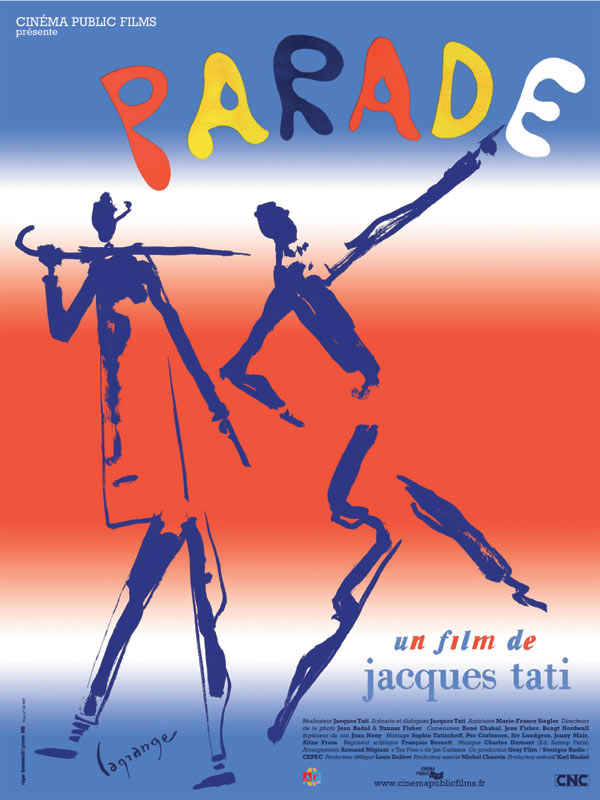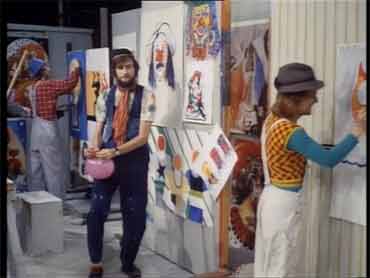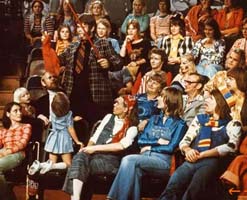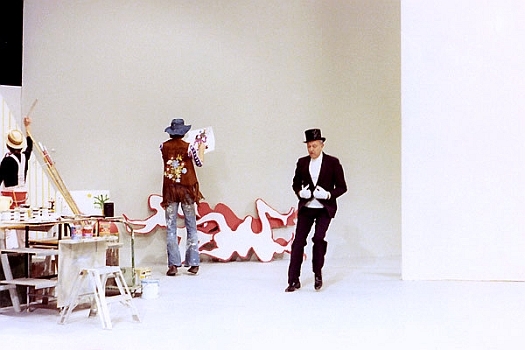I continue to find it astonishing that a film as important as Jacques Tati’s Parade continues to be ignored and unrecognized by most critics. This article about the film was published in the December 1, 1989 issue of the Chicago Reader. —J.R.
PARADE
**** (Masterpiece)
Directed and written by Jacques Tati
With Tati, Karl Kossmayer, the Williamses, the Veterans, the Argentinos, Pia Colombo, Johnny Lonn, Bertilo, Jan Swahn, Bertil Berglund, and Monica Sunnerberg.
1. Jacques Tati’s last feature, Parade (1973), is about as unpretentious as a film can get. One of the first films to have been shot mostly in video (on a shoestring budget for Swedish TV), it’s a music-hall and circus show featuring juggling, music, gags, pantomime, minor acrobatics, and various forms of audience participation. Though it might seem a natural for TV––and in fact has been shown on TV, as well as theatrically, in Europe––it has never been broadcast in this country. Most critics who have seen it, including many passionate Tati fans, regard it as minor and inconsequential. (A striking and valuable exception is Kristin Thompson, whose article on it appeared in the film journal the Velvet Light Trap three years ago.) When, in 1984, a severely mutilated version––missing at least 15 minutes, including the crucial and sublime epilogue––was released in England, London reviewers who scream bloody murder if slasher films are slightly trimmed couldn’t be bothered to raise even a minor protest.
When the uncut movie ran briefly at Facets Multimedia Center three years ago––the only theatrical run it has ever received in the U.S.––practically no one went to see it. Since Tati’s movie seems to have joined the legion of the damned, one might well wonder why I am going to the trouble of making a big deal out of it.
I don’t wish to argue that Parade (returning to Chicago for two screenings at the Film Center this weekend) is a work of undiscovered depths, any more than Tati’s other half dozen features are. The paradoxical thing about all of his films is that what you see (and hear) is what you get; like Poe’s purloined letter, it’s all there, right on the surface––if we are alert enough to observe what is happening right in front of us. But thanks to a lifetime of bad training in watching movies and TV, we often can’t be that alert. Parade is devoted to showing us how we could be.
2. Sometimes the most radical and profound ideas turn out to be very simple. Some of the most radical and profound ideas in Parade are at least as old as Brueghel, although they’re a good deal fresher and considerably more advanced than those in any of the commercial features released this year. A few of these ideas can be represented in simple sentences, all of them having to do with the nature of spectacle, and all of them saying pretty much the same thing:
There is no such thing as an interruption.
There is no such thing as “backstage.”
At no point does life end and “the show” begin––or vice versa.
Amateurs and nobodies––that is to say, ordinary people––are every bit as important, as interesting, and as entertaining as professionals and stars.
Poetry always takes root in mundane yet unlikely places, and it is taking place all around us, at every moment.
3. Simple ideas, and in the film they’re all expressed exclusively in terms of light entertainment; yet 16 years after Parade’s release, they remain elusive, difficult, complex, and highly subversive in relation to most notions about the art of spectacle that circulate today. Worse yet, they are often expressed in terms that are unfashionable, in relation to either 1973 or the present.

When a European rock band performs in the film, for instance, it is the unhippest hippie band imaginable, at least by our own standards, and when we see some of the youths in the bleachers clap and dance to the music, we become painfully aware of Tati’s remoteness from that segment of his audience (he was in his mid-60s when he made Parade). Even in Playtime (1967), Tati’s supreme masterpiece, the gaucheness and lack of stylishness of the leading female character, a young American tourist, represents a stumbling block for many viewers.
Still another potential problem is represented by the visual quality of the video in Parade, which is fairly muddy by contemporary standards. Tati was probably the first major filmmaker to shoot in videotape, and he approached it with the same artisanal craft and innovative daring that he brought to cinema; but the technical options available in video in 1973 were far from what they are today. To the best of my knowledge, the only previous theatrical color feature shot mainly or wholly in video was Frank Zappa and Tony Palmer’s dreadful Two Hundred Motels (1971); the visual clarity of Parade is light-years ahead of the quality of that film, but it is still a far cry from the overall definition available in video transfers today. There are certainly positive and even exciting aspects of witnessing the birth of a new medium (an experience afforded in similar ways by some of the earliest films, made around the turn of the century) ––but for a contemporary audience it is also liable to be somewhat disconcerting, or, even worse, disheartening.
4. One of our besetting limitations in relation to art is that we tend to distrust pretension, yet at the same time we’re wary of taking entertainment seriously if it doesn’t wear art with a capital A on its sleeve. A look at the career of Woody Allen offers distressing evidence of what it takes to be taken seriously as a film artist in this culture: not original uses of image or sound (in fact, the more like secondhand Bergman or Fellini the better), not a unique vision of the world or how to deal with it (cf the New York Times); all it takes is an array of cultural references and the proper amount of gloom and doom to register true artistic intentions.
Tati’s refusal––or inability––to make movies that were fashionable or conventionally slick didn’t prevent his first three features––Jour de fete (1949), Mr. Hulot’s Holiday (1953), and Mon oncle (1958) ––from becoming worldwide hits, each bigger than the last. All three films were highly original and eccentric expressions––in their loose and unconventional attitude toward narrative, in their peculiar handling of humor, in their satirical comments on the periods and milieus in which they were made, in the sorts of characters and behavior they focused on, and in their unique employments of sound, pacing, editing, and framing. Yet the truth of Tati’s observations was so immediately recognizable to the general public that none of these idiosyncrasies stood in the way of commercial success.
But when Tati made his most ambitious, accomplished, and expensive movie, Playtime, building and expanding upon everything he knew, the public wasn’t ready for it. In Playtime the five maxims about spectacle cited above––particularly the idea about stars and ordinary people, already integral in many ways to both the conceptions of the previous films and the experiences they offered–were pushed to even more radical and innovative extremes.
In an attempt to sabotage the centrality of Hulot, the character Tati had created and played in his two previous features, Tati in Playtime created a series of false Hulots––characters who resembled Hulot from a distance––which deliberately and productively confused both on-screen characters and the audience. (In the final sequence, when Hulot buys a farewell gift for the American tourist, it is significantly one of the false Hulots who winds up delivering it.) But the public only wanted more of their hero Hulot, not a mechanism demonstrating that everyone else––on the screen and in the audience––was equally funny and important.
From then on, Tati’s career operated under a shadow that persists to this day––not merely because of the box-office failure of Playtime, which landed him in bankruptcy, but also because it had become painfully clear that Tati’s vision threatened the politics of spectacle as we know it. The democratic, nonelitist idea that three dozen characters can all be on-screen at once and can all be equally worthy of interest––which is central to the hour-long climactic sequence in Playtime devoted to the opening of a restaurant, conceivably the most richly orchestrated piece of mise en scene in the history of cinema––sabotages not only the star system, but principles of story telling, dramaturgy, composition, foreground and background, and moral and social hierarchies central to other movies. And indeed, the immediate consequence of this crisis was that Tati was forced to make a conscious regression in his next film (Trafic)––bringing back Hulot as a more central character in a simpler and more conventional story––in order to continue making movies at all. (Trafic, one should add, has plenty of beauties and wonders of its own––Tati was incapable of making an indifferent film––but it is significantly the only one of his features that betrays any bitterness. This comes to the surface most noticeably in the treatment of its leading female character––a flashy, phony, and superficial public-relations officer who embodies the pressures of commerce.)
5. I can speak of Tati’s intentions with some confidence because I was privileged to have worked for him on an unrealized feature called “Confusion” in 1972, the year after Trafic was released. Tati was trapped in the paradox of being loved all over the world for his creation, a character he had grown to detest; it was Hulot who stood in the way of Tati’s desire to grow as a filmmaker. This is not to say that Tati had ceased to be a performer; our four- and five-hour work sessions were dominated by his impromptu performances (and my so-called job as “script consultant” consisted of responding to those performances). But it is equally important to note that, for him, the role of performer and the role of spectator were inseparably linked.
He had started out as an athlete and amateur comic whose routines, based on what he saw and heard, led to an extended stint in music halls, and all his movies were vast frescoes of observations that became inventions only when he tried to duplicate and/or develop them. Having lunch with Tati in a bistro mainly consisted of sitting next to him in front of the spectacle of everyday life, which he was constantly reacting to and mimicking; “scripting” a film sequence, for him, mainly consisted of remembering such moments and translating them into shots––duplicating with his body and voice everything that one would see and hear. A purely intuitive rather than intellectual process, based less on words than on sounds and images, it equated acting with watching and watching with acting to such a degree that it dissolved the usual distinctions between the two.
6. Parade’s title appears over a drumroll, in the form of a multicolored marquee in the night sky above a circus building, and the camera pulls back from this building before cutting to a closer shot of people filing in. Then the first “gag” occurs––a detail so slight that by conventional standards it hardly qualifies as a gag at all, although it is quintessential Tati: a teenager in line picks up a striped, cone-shaped road marker on the pavement and dons it like a dunce cap; his date laughs, finds another road marker, and does the same thing.
At least three basic Tatiesque principles are set forth in this passing detail. There is the notion of bricolage, or the appropriation of impersonal objects for personal use that enables people to reshape and reclaim their environment, an idea central to Tati’s work (the restaurant sequence in Playtime formulates it on an epic scale), which reaches its distilled essence throughout Parade, both offstage and on. (Tati, one should note, directed all the stage acts himself, altering in some instances the performers’ usual props, costumes, and gestures, such as getting the jugglers to juggle with paintbrushes––another good example of bricolage.)
Then there is the offhand inflection and punctuation of the gag, making it a slightly disorienting moment of strangeness in the midst of normality rather than the conventional setup followed by a payoff. (Critic Jean-André Fieschi has aptly noted that Tati’s gags “are not placed in salient positions, as are the bon mots in boulevard theater. Every remarkable idea seems clogged, every flash of wit annulled in a kind of imperturbable equalization.”) As a consequence, the dunce-cap gag is more likely to make us smile than laugh; but the cumulative effect of dozens of such underplayed gags is to make reality itself seem both slightly off-kilter and alive with comic possibilities––every moment brims with potential gags that often require an audience’s alert participation in order to be noticed at all.
Finally, one should note that at the very outset, Tati is placing spectators rather than performers in the primary creative role. The “parade” begins before the audience even enters the theater, as is fully apparent in the brightly colored, festive, and flamboyant clothes worn by the hippies in the audience as well as the props carried by many of the younger kids. The implication of this principle, along with the preceding two, is that Tati’s democratic aesthetics are more than just a matter of everything and everyone in a shot being worthy of close attention. They also function on a temporal plane––every shot and moment is worthy of close attention, and a moment without a fully articulated gag is not necessarily inferior to a moment with one, because the spectator’s imagination is unleashed by the mere possibility that one might occur.
One of the kids, a little girl wearing a gun and holster, stops briefly inside the lobby to adjust her gear, and briefly makes eye contact with a little boy before each of them is dragged off in opposite directions by his or her respective parent (her mother and his father). These are the same two children who will literally take over the movie in the epilogue, entering the empty stage and playing with various props as they try to reproduce the acts they have seen. They are also seen periodically in the bleachers throughout the show––the girl in the front row, the boy behind her––and their responses to the show and each other are accorded at least as much attention as any of the acts. [See production still of Tati with the girl, below.]
7. The movie lingers over a good many other preliminaries before the circus actually begins: people drifting to their seats, musicians tuning up, carpenters and painters (who later prove to be performers) working on props. The fact that these activities are as important as what follows dawns on us only gradually, in part because it becomes difficult to determine when and where the show does begin. When the opening trumpet fanfare is played by two clowns in the bleachers, many spectators are still arriving, and the camera seems so distracted by such details that we come to accept the fanfare, the following introduction of performers, and a subsequent drum fanfare as part of the preliminaries, too. Even when Tati himself strolls onstage in a top hat and is greeted by applause, the camera abruptly sweeps past him to settle on the front rows in the bleachers, where the little boy is clearly bored out of his wits, and the little girl, while applauding (along with her mother) in the row ahead, is looking at the boy, not at Tati.
When Tati, the official master of ceremonies, begins to speak, it is in a multilingual, semi-nonsensical patter that goes something like this: “We have the pleasure of presentera a show where everybody can, for I may, I am pleased to include you, me, we are all together around ménage called parade––” But then the camera cuts away from him again to focus on the drifting trajectories of a wandering toddler, proceeds out into the lobby to linger on a latecomer checking his motorcycle helmet at the cloakroom (which makes a loud clunk when it hits the counter), remains with the befuddled female attendant surrounded by a sea of other helmets, then proceeds down a hallway to the comic entrances and exits of a hockey player and a violinist. When the camera finally returns to the auditorium, it is to the bleachers, where another motorcyclist is asked by the woman seated behind him to remove his helmet so she can see better––but his decompressed hair creates even more of an obstruction. Finally we get to see the musicians playing onstage, but from an oblique overhead angle that includes the stage rigging.
Even when the camera spends more time on the stage, the physical borders of spectacle and audience are broken down through a variety of means. The painters and carpenters working on props are frequently visible and even prominent as spectators during some of the acts. (Only much later, when a painter starts competing with an onstage magician in performing card tricks, and when several of the painters start juggling with their paintbrushes, does it become fully apparent that these characters are “performers” rather than “extras.”) An onstage row of fake bleachers containing black-and-white cutouts of spectators is integrated into some of the acts; this effect is undermined in turn when real spectators are later glimpsed in the same spot, or when fake spectators are glimpsed in the actual bleachers. Time and space often become mutable (as they are in Raúl Ruiz’s dance film Mammame), but the premise as well as the illusion of a show taking place in real time and on a single stage is rigorously maintained.
8. Among the acts included––tumblers, musical novelties, a singer (Pia Colombo) introduced from the audience, and an audience-participation interlude involving an obstreperous mule––are many of Tati’s most famous music-hall pantomimes, depicting a football game, a fisherman, a tennis match, a tennis player circa 1900, and a horseback rider. The continuity between these solo routines and Tati’s directorial style is that both appeal to a spectator’s imagination through a panoply of subtle suggestions. (Reviewing one of Tati’s mime performances in 1936, Colette wrote, “He has created at the same time the player, the ball and the racket; the boxer and his opponent; the bicycle and its rider. His powers of suggestion are those of a great artist.”)
While it might seem from the foregoing description that Tati somehow undercuts the performers (himself included) in order to glorify the spectators, he actually treats them all with respect. His directorial sleight of hand keeps bringing the audience into the act, but never in such a way that it betrays or impugns the talents of the performers. It is the ideology of spectacle and its attendant hierarchies that he is out to dismantle––not the pleasures of spectacle itself, which he is in fact inclined to spread around liberally and democratically, emphasizing its continuities with everyday life.
9. A central aspect of Parade that makes it more contemporary and more in tune with advanced filmmaking than all its other qualities is complex interaction between nonfiction and fiction, chance and programming––a dialectical approach followed with comparable fruitfulness in such films as Jacques Rivette’s Out 1: Spectre, Orson Welles’s F for Fake, Chris Marker’s Sans soleil, Francoise Romand’s Mix-Up, Claude Lanzmann’s Shoah, Joris Ivens and Marceline Loridan’s A Story of the Wind, and the most recent works of Peter Thompson and Leslie Thornton.
Tati began by shooting with an audience in the circus building for 3 days, using four video cameras. Then he spent 12 days in a studio reshooting portions of the stage acts in 35-millimeter. Thus he wound up with a film that combines spontaneous and planned material on video with planned material on film, and although the visual definition in the studio-filmed portions is noticeably sharper, the mixture of materials is so deft in other respects that it is generally impossible to separate the documentary segments from the fictional details. The sole exception to this is the film’s epilogue and pièce de résistance, in which the boy and girl are left alone with the stage props after the show has ended. Tati shot two hours of their improvised play with several video cameras, then extracted the few minutes that are used in the film.
The studio shooting of Playtime, which entailed the construction of an entire city set, precluded such experimentation––the only real location used in the film is the exterior of Orly airport––but some early forays into documentary can be found in certain sequences of Trafic, detailing the behavior and habits of various drivers, which are so gracefully threaded into the rest that they register as a continuation of the fiction rather than a departure from it.
10. Expanding this technique considerably, Parade creates a privileged zone of its own in which the free play between fiction and nonfiction becomes an open space to breathe in. It is a utopian space where equality reigns between spectators and performers, children and adults, foreground and background, entertainment and everyday life, reality and imagination––an evening’s light diversion that, if taken seriously, as it was meant to be, could profitably crumble the very ground beneath our feet.
Published on 01 Dec 1989 in Chicago Reader, by jrosenbaum






